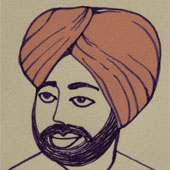The turban of a Sikh is a gift given on Bai- Sakhi Day of 1699 by the Tenth Master, Guru Gobind Singh. After giving Amrit to the Five Beloved Ones, he gave Sikhs Bana, the distinctive dress that includes the turban.
During Guru Gobind Singh’s time, the turban, or “dastar,” as it is called in Persian, carried a totally different connotation from that of a hat in Europe. The turban represented respectability and was a sign of nobility. At that time, a Mughal aristocrat or a Hindu Rajput could be easily distinguished by his turban. The Hindu Rajputs were the only Hindus allowed to wear ornate turbans, carry weapons and have their mustache and beard. Also at this time, only the Rajputs could have Singh (“lion”) or Kaur (“princess”) as their second name. Even the Gurus did not have Singh as part of their name, until the Tenth Guru.
The downtrodden followers of the Sikh faith did not have the means to display aristocratic attire, nor were they allowed to, even if they had the means. (Doing so was usually equivalent to a death sentence.) It was in this context that Guru Gobind Singh decided to turn the tables on the ruling aristocracy by commanding every Sikh to carry a sword, take up the name Singh or Kaur, and have kesh (hair) and turban displayed boldly, without any fear. This effectively made his followers see themselves as on par with the Mughal rulers.

The first batch of 5 beloved ones received the rites of the two-edged sword from Guru Gobind Singh. (Image Source)
Source: ‘Pag ate Pag da Sabhiachar’ Book by Jagdev Singh Aulakh. Translated from the original in Punjabi.

